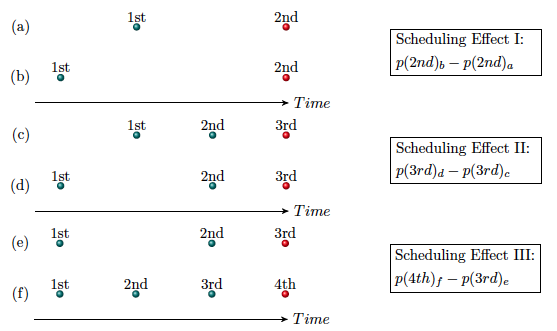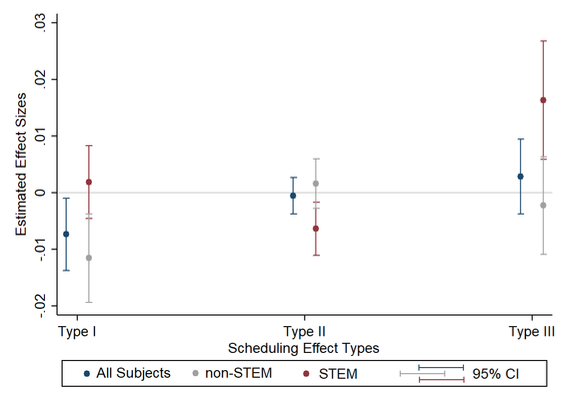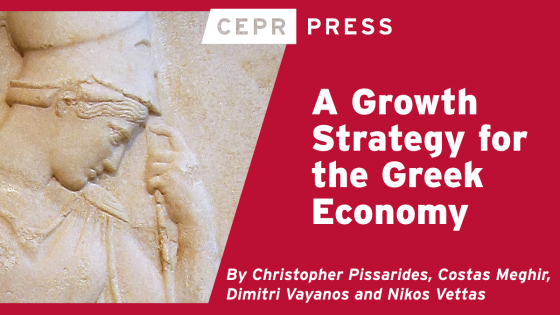In most educational systems, students are required to complete tasks such as projects and exams in finite time periods. In many countries, all high school students take a sequence of final exams within a short period of time and with only a few days at most between exams. Performance in these exams is paramount for progression to the next grade, and exam scheduling may be an important driver of students’ performance. For example, Pope and Fillmore (2015) find that performance is positively associated with the time between exams. however, this is only one aspect of task scheduling. Other aspects may include the order in which exams are completed and the number of exams to be completed in a given time period.
In a recent paper (Goulas and Megalokonomou 2019), we ask: What is the effect of having completed an additional exam on later performance? Do we see evidence of fatigue as students take more exams? Our research questions are motivated by a practical concern of how exams can be optimally scheduled.
Although the importance of exam schedules is obvious, it has received little attention in the literature. In particular, there is a lack of causal evidence on how scheduling affects student achievement, since in most settings course assignment is usually not random and individuals who select into certain courses may also select into a particular exam schedule for those courses. At the same time, individuals’ preferences or other engagements may also influence their exam schedules. Endogeneity arising from unobservables that drive both selection into courses and selection into exam schedules renders the identification of the scheduling effects on exam performance challenging.
In our paper, we explore the different channels through which exam scheduling affects performance. We exploit quasi-random variation in exam timing across cohorts, subjects, and grades to identify the distinct effects of the number of days between exams, the number of days since the first exam, and the exam order on subsequent performance.
To address the issue of endogeneity, we exploit a novel dataset on exam scheduling and student performance in a Greek public high school that used a lottery to generate exam schedules. Our dataset covers exam performance in all subjects for nine cohorts of students in the 10th and 11th grades between the school years 2001-2002 and 2009-2010.
At the end of each school year, between May and June, high school students take compulsory written exams in every subject taught. Exam schedules are announced after the last day of classes in each year. The exam season lasts between three to four weeks, with each student taking exams in more than 13 subjects on average.
We compare exam performance across subjects, grades, and cohorts of students who have similar characteristics and face the same school environment, except for the fact that each subject has different exam timing across grades and cohorts, due to purely random factors. We also explore how scheduling effects vary by prior performance and gender; this has not previously been attempted in the literature.
To our knowledge, ours is the first paper to use quasi-random variation in exam timing across cohorts, grades, and subjects from a lottery to identify three contemporaneous channels through which exam scheduling may affect performance:
- Scheduling effect I: The first channel through which scheduling affects exam performance is the number of days between exams. Time between exams may lend itself to preparation or recuperation, and the effect of the length of time between exams on subsequent performance may be a composite effect of preparation and potential distraction.
- Scheduling effect II: Considering a sequence of exams individuals must take in a given time period, the second channel corresponds to the effect on performance of the time between the first exam and the exam that students are about to take. It may capture fatigue from exam completion.
- Scheduling effect III: The third channel relates to how many exams have been taken before sitting an additional exam. It may reflect warm-up or practice effects from exam completion.
Figure 1 presents the three channels in a simple schematic of sequential exam productivity in which a student is subjected to a finite number of exams under different schedules. The randomness in exam scheduling achieved through the lottery guarantees the orthogonality of subject type (i.e. STEM1 or non-STEM) and student characteristics (i.e. prior performance) on the exam scheduling of compulsory subjects across cohorts and grades.
Figure 1 Scheduling effects on exam performance
Different scheduling effects in STEM and non-STEM subjects
Figure 2 shows that the number of days between exams, the number of days since the first exam, and the exam order have distinct marginal influences on exam performance.
We find significant scheduling effects particularly in STEM subjects. Exam productivity in STEM courses increases with exam order, suggesting the existence of a learning effect that is positively associated with taking an additional exam. Exams taken later in the schedule are associated with higher performance (practice or warm-up effect), controlling for other influences of exam scheduling, such as preparation time between exams and overall fatigue, proxied by the number of days since the first exam. Students randomly assigned to a later place in the exam order earn a grade on that exam that is significantly higher than the grades of students randomly assigned an earlier place in the exam order for the same course.
Figure 2 Estimated scheduling effects on performance
At the same time, exam performance is found to decrease with the number of days since the first exam, suggesting that an additional day in the exam season is associated with exam fatigue, particularly in STEM courses. A one-day increase in the day count since the first exam significantly decreases the student’s subsequent performance on STEM-related exams (fatigue effect).
For STEM subjects, the estimated warm-up effect is larger than the estimated fatigue effect. The number of days between exams is found to be associated with decreasing exam performance only in non-STEM courses, controlling for other influences.
Different scheduling effects on males and females
Policymakers may be interested in understanding the implications of exam scheduling, especially when it may affect the performance gap in STEM subjects between males and females. We explore differential scheduling effects on exam performance by gender and find that exam productivity increases faster for boys than it does for girls as they take additional exams. In addition, boys’ exam performance benefits more from additional time between exams than girls’ performance.
Different scheduling effects for higher- and lower-performing students
We also explore differential effects across prior performance levels, proxied by midterm scores. Students in the top quantile of prior performance enjoy a significantly higher warm-up effect from additional exams in both STEM and non-STEM courses, compared with students in the bottom quantile.
In addition, students in the top quantile of prior performance exhibit lower fatigue effect, associated with an additional day in the exam season, in STEM courses. Additional days between exams are found to improve STEM-related performance more for students in the top quantile of prior performance than for students in the bottom quantile.
The results are reversed when performance in non-STEM courses is considered. In particular, students in the bottom quantile of prior performance show a more positive effect from an additional day between exams (recuperation effect) in non-STEM courses compared with students in the top quantile.
Optimal exam schedule
As families, teachers, and administrators seek ways to improve student academic performance, some ask what the optimal exam schedule is. Our series of simulation experiments show that the higher the number of exams taken, the higher the potential benefit from optimising exams scheduling. Optimising the exam schedule can improve overall performance by as much as 0.02 standard deviations.
References
Pope, D G, and I Fillmore (2015). “The impact of time between cognitive tasks on performance: Evidence from advanced placement exams”, Economics of Education Review 48: 30–40.
Goulas, S, and R Megalokonomou (forthcoming). “Marathon, hurdling or sprint? The effects of exam scheduling on academic performance”, The B.E. Journal of Economic Analysis and Policy.
Endnotes
1 STEM refers to fields of study related to science, technology, engineering, or mathematics.





